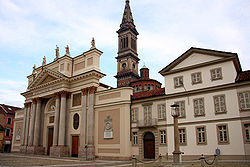Alessandria
| Alessandria | |||
|---|---|---|---|
| Comune | |||
| Comune di Alessandria | |||

Alessandria Cathedral on the Piazza del Duomo
|
|||
|
|||
| Location of Alessandria in Italy | |||
| Coordinates: 44°55′N 08°37′E / 44.917°N 8.617°ECoordinates: 44°55′N 08°37′E / 44.917°N 8.617°E | |||
| Country | Italy | ||
| Region | Piedmont | ||
| Province / Metropolitan city | Alessandria (AL) | ||
| Frazioni | Spinetta Marengo, Castelceriolo, Lobbi, San Giuliano Nuovo, San Giuliano Vecchio, Mandrogne, Cascinagrossa, Litta Parodi, Valle San Bartolomeo, San Michele | ||
| Government | |||
| • Mayor | Maria Rita Rossa (PD) | ||
| Area | |||
| • Total | 204 km2 (79 sq mi) | ||
| Elevation | 95 m (312 ft) | ||
| Population (31 August 2009) | |||
| • Total | 93,922 | ||
| • Density | 460/km2 (1,200/sq mi) | ||
| Demonym(s) | Alessandrini, Mandrogni | ||
| Time zone | CET (UTC+1) | ||
| • Summer (DST) | CEST (UTC+2) | ||
| Postal code | 15121-15122 | ||
| Dialing code | 0131 | ||
| Patron saint | San Baudolino | ||
| Saint day | November 10 | ||
| Website | Official website | ||
Alessandria [alesˈsandrja] ![]() listen (Piedmontese: Lissandria) is a city and comune in Piedmont, Italy, and the capital of the Province of Alessandria. The city is sited on the alluvial plain between the Tanaro and the Bormida rivers, about 90 kilometres (56 miles) southeast of Turin.
listen (Piedmontese: Lissandria) is a city and comune in Piedmont, Italy, and the capital of the Province of Alessandria. The city is sited on the alluvial plain between the Tanaro and the Bormida rivers, about 90 kilometres (56 miles) southeast of Turin.
Alessandria is also a major railway hub.
Alessandria was founded in 1168 with a charter as a free commune; it was sited upon a preexisting urban nucleus, to serve as a stronghold for the Lombard League, defending the traditional liberties of the communes of northern Italy against the Imperial forces of Frederick Barbarossa. Alessandria stood in the territories of the marchese of Montferrat, a staunch ally of the Emperor, with a name assumed in 1168 to honor the Emperor's opponent, Pope Alexander III. In 1174–75 the fortress was sorely tested by Imperial siege and stood fast. A legend (related in Umberto Eco's book Baudolino, and which recalls one concerning Bishop Herculanus’ successful defense of Perugia several centuries earlier) says it was saved by a quick-witted peasant, Gagliaudo: he fed his cow with the last grain remaining within the city, then took it outside the city walls until he reached the Imperial camp. Here he was captured, and his cow cut open to be cooked: when the Imperials found the cow's stomach filled with grain, Gagliaudo was asked the reason to waste such a rich meal. He answered that he was forced to feed his cow with grain because there was such a lot of it, and no room to place it within the city. The Emperor, fearing that the siege would last too long, left Alessandria free. (Malaria was probably the real cause of his departure.) A statue of Gagliaudo can be found on the left corner of the city cathedral.
...
Wikipedia



